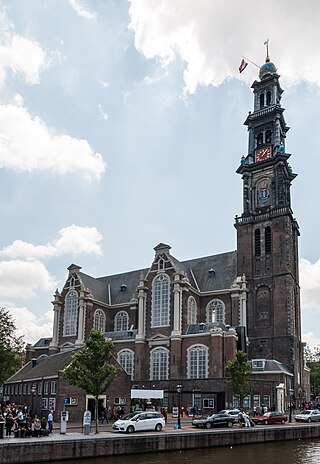
The Westerkerk is a Reformed church within Dutch Protestant Calvinism in central Amsterdam, Netherlands. It lies in the most western part of the Grachtengordel neighborhood, next to the Jordaan, between the Prinsengracht and Keizersgracht.

The Grote Kerk or St.-Bavokerk is a Reformed Protestant church and former Catholic cathedral located on the central market square in the Dutch city of Haarlem. Another Haarlem church called the Cathedral of Saint Bavo now serves as the main cathedral for the Roman Catholic Diocese of Haarlem-Amsterdam.
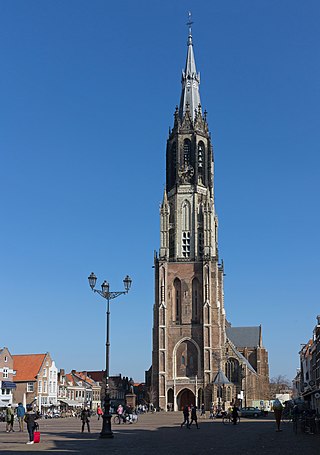
The Nieuwe Kerk is a Protestant church in the city of Delft in the Netherlands. The building is located on Delft Market Square (Markt), opposite to the City Hall. In 1584, William the Silent was entombed here in a mausoleum designed by Hendrick and Pieter de Keyser. Since then members of the House of Orange-Nassau have been entombed in the royal crypt. The latest are Queen Juliana and her husband Prince Bernhard in 2004. The private royal family crypt is not open to the public. The church tower, with the most recent recreation of the spire which was designed by Pierre Cuypers and completed in 1872, is the second highest in the Netherlands, after the Domtoren in Utrecht.

The Oude Kerk, nicknamed Oude Jan and Scheve Jan, is a Gothic Protestant church in the old city center of Delft, the Netherlands. Its most recognizable feature is a 75-meter-high brick tower that leans about two meters from the vertical.

The Oude Kerk is Amsterdam’s oldest building and youngest art institutes. The building was founded circa 1213 and consecrated in 1306 by the bishop of Utrecht with Saint Nicolas as its patron saint. After the Reformation in 1578, it became a Calvinist church, which it remains today. It stands in De Wallen, now Amsterdam's main red-light district. The square surrounding the church is the Oudekerksplein.

Pieter Hemony and his brother François Hemony were the greatest bellfounders in the history of the Low Countries. They developed the carillon, in collaboration with Jacob van Eyck, into a full-fledged musical instrument by casting the first tuned carillon in 1644.

The Hooglandse Kerk is a Gothic church in Leiden. Its earliest parts date back to the last quarter of the fourteenth century. Most of the current structure dates from the fifteenth century. The brick church was dedicated to St. Pancras and today serves parishioners of the Protestant Church in the Netherlands.

The Nieuwe Kerk is a Dutch Baroque Protestant church in The Hague, located across from the modern city hall on the Spui. It was built in 1649 after the Great Church had become too small. Construction was completed in 1656.
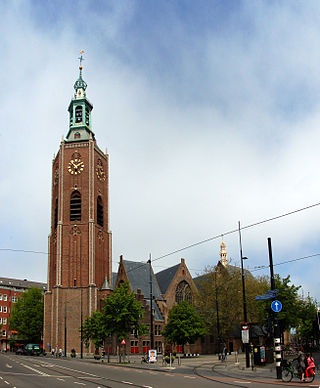
The Great Church or St. James' Church is a landmark Protestant church in The Hague, Netherlands. The building is located on the Torenstraat, named for its high tower. Together with the Binnenhof, it is one of the oldest buildings in The Hague. Members of the House of Orange-Nassau have been baptised and married there. The latest are Willem-Alexander of the Netherlands and his daughter Catharina-Amalia, Princess of Orange.

Grote or Sint-Laurenskerk is a landmark formerly Protestant church in Alkmaar, Netherlands, now in secular use. The building is located on the Koorstraat. It is mostly closed in the winter and open for tourists in the summer months or by appointment.

The Ronde Lutherse Kerk or Koepelkerk is a former Lutheran church in Amsterdam, Netherlands, on the Singel canal. The church can be easily seen from the Singel, identified by its copper dome.

The Oostkerk is a Protestant church in Middelburg. The church can be spotted on the Middelburg horizon by its characteristic round dome.

The Nieuwe Waalse Kerk is a late 19th-century church building on the Keizersgracht canal in Amsterdam. The building, a rare example of Romanesque Revival architecture in Amsterdam, has rijksmonument status.
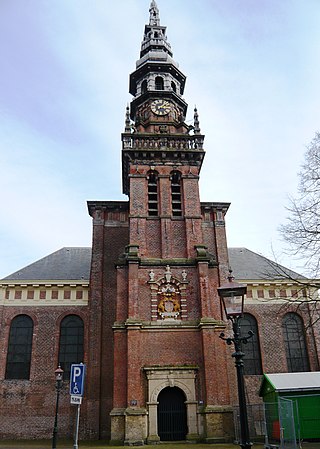
The Nieuwe Kerk is a historical Protestant Reformed church dating from the 17th century on the Nieuwe Kerksplein in Haarlem, Netherlands.
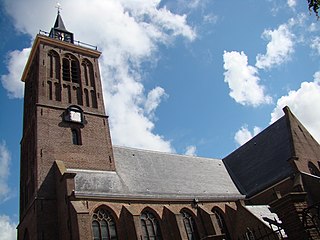
The Grote Kerk is a Protestant church in De Rijp, Netherlands, located near the Town Hall. The church is known for its 17th-century stained-glass windows.

Willem Hendrickszoon de Keyser was a Dutch Golden Age architect and sculptor primarily active in Amsterdam and London.

The Walloon Church is a Protestant church building in Amsterdam, along the southern stretch of the Oudezijds Achterburgwal canal. The building dates to the late 15th century and has been in use as a Walloon church since 1586. The church was also known as the Franse Kerk, Walenkerk, Oude Walenkerk, or Oude Waalse Kerk.

The Waag building is a National monument (Rijksmonument) listed building on the Waagplein in Alkmaar in the Netherlands. On this square Waagplein every Friday from April till the second week of September, the famous cheese market is held. The Dutch Cheese Museum and the tourist information Office (VVV) are also in the building. In the tower is a famous carillon weekly played by a carillonneur and also automatically by a drum chiming the quarters of the hour. There is also the famous automatic horse with knights play in the tower with an automatic trumpetplayer.

The Saint Hippolytus Chapel is a chapel in the old city of Delft. It is one of the oldest buildings in Delft, and since 1967 it has been designated the Rijksmonument.






















